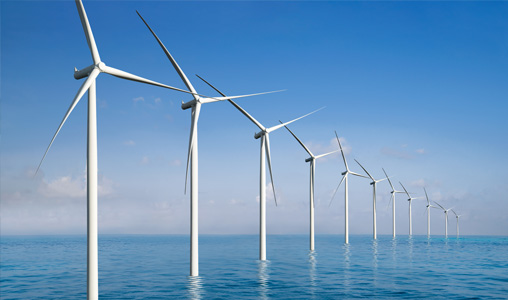THE EU LEADS THE TRANSITION TO RENEWABLE ENERGY
In the context of electricity market, a rapid growth of renewable energy production is emerging globally, while some Asian countries, mainly China and India, continue to increase production capacity from fossil sources due to the rapid increase in demand. The EU-27 is leading the global energy transition and is expected to generate more than 40 per cent of its energy from renewable sources by 2030.
GEOPOLITICAL AND ECONOMIC CHALLENGES IN THE OIL MARKET
The oil market is influenced by several factors and variables, which make the situation uncertain. After a long period of volatility, first due to the war between Russia and Ukraine and then to the attacks on ships crossing the Suez Canal, the oil market is now greatly influenced by the evolving situation in the Middle East. Within this framework, the oil price premium linked to geopolitical risk, which had previously been much reduced, has been reconstituted -at least partially. The OPEC+ countries (which include -among others- Venezuela, Saudi Arabia, the major Gulf countries, but also Russia and others), at their summit on 2 June 2024, agreed on a gradual plan for production cuts. In any case, the OPEC+ countries declared they are ready for possible adjustments to the cut programme in order to adjust and stabilise prices. Among non-OPEC+ countries, however, it should be noted the continued increase in oil production in recent years by the United States, which have now recovered the record production levels achieved before the COVID pandemic. Given the various factors affecting oil prices, estimates vary depending on the economic and geopolitical context. Recently, market analysts revised downwards their estimates for the price of Brent crude, which would settle in the range of USD 70-80 per barrel.
LNG, MARKET TRENDS AND GROWTH FORECASTS
The global LNG (Liquefied Natural Gas) market contracted by 1% on an annual basis in the second quarter of 2024, reaching 99 MMt of demand. The decrease in industrial LNG needs and mild winter weather meant that gas storage levels were high at the beginning of 2023 and remained at record levels during the winter of 2023-2024, reducing the demand for LNG in Europe. As a result, there has been a sharp reduction in LNG imports in Europe. At the end of June 2024, the level of storage in Europe, excluding Ukraine, reached 76%, up 7% from the previous month and 11% higher than the average for the period 2020-2023. In the long term, the global LNG market is expected to remain contracted until the new projects in the United States and Qatar come on stream, from 2025-2026.
GLOBAL TARGETS FOR RENEWABLE ENERGY OF COP 28
For the renewable energy outlook , during the COP 28 climate change conference held in Dubai at the end of 2023, more than 130 national governments, including the EU, agreed to work together to achieve the goal of tripling the world's installed renewable energy capacity to 11,000 GW by 2030, including 4,000 GW of hydropower. Renewable energy is expected to overtake coal from 2025, becoming the main energy source for electricity production at a global level. By 2028, 68 countries will use renewable resources as the main source of electricity, being, however, only 17% of global demand (today 57 countries represent 14%). The EU is experiencing rapid growth in installed renewable capacity. In India, an installed capacity of 125 GW from renewable sources was reached in 2023. China maintained its leading status in capacity addition in 2023, with a booming market for both photovoltaic (plus 116% on an annual basis) and wind power (plus 66% on an annual basis).

SUSTAINABLE INVESTMENTS
With regard to sustainability investments, the EMEA area was the region with the highest investments in 2023, with an annual growth of 38%, reaching USD 542bn. This is the result of a good year for solar energy in Europe and the growth of the electric vehicle market, as well as increases in hydrogen, CCS (Carbon Capture and Storage) and clean industry sectors. Globally, investments for the energy transition increased by USD 258bn in 2023. Much of this increase was driven by the EU-27, United States and United Kingdom. Among the ten countries with the highest investments, five are European. The EU has invested more in sustainability than the United States, with a total of USD 341bn in 2023. Germany maintained the third place with investments mainly in electrified transport. China in energy transition investments, for a total value of USD 676bn in 2023.
INVESTING IN SOLAR ENERGY
In Europe relevant investments in solar energy reached USD 43bn in 2023, driven by Spain, Germany and the Netherlands. Outside Europe, South Africa and Saudi Arabia have experienced the greatest growth in solar energy investments. 2023 was another record year for photovoltaic solar power in the EU, with 55.9 GW installed, a doubling of installed capacity in just two years. The EU will experience double-digit growth every year.
INVESTING IN WIND POWER
The United Kingdom showed particular volatility in wind power investments, due to the offshore wind subsector, which is characterised by the complexity and size of projects. Germany leads the development of onshore wind power in the EU, being the first European country in terms of capacity (7 % of the total installed capacity at a global level), followed by Spain, France and the United Kingdom. Germany will remain Europe's largest wind power market, with an increase in construction capacity over the next five years of 18 GW for onshore and 6 GW for offshore. The EU is expected to install 64.4 GW of onshore wind power capacity between 2024 and 2027.
SOURCE Bloomberg, S&P (Standard and Poor’s)